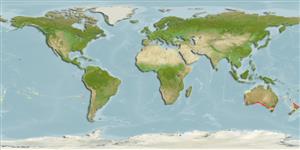Common names from other countries
Environment: milieu / climate zone / depth range / distribution range
экология
морской ассоциированный с рифами; пределы глубины 0 - 400 m (Ref. 58302), usually 15 - 60 m (Ref. 30464). Subtropical; 19°S - 42°S, 114°E - 76°W
Eastern and western South Pacific: Exact distribution unknown because of taxonomic uncertainties.
Size / Вес / Возраст
Maturity: Lm ? range ? - ? cm
Max length : 55.0 cm FL самец/пол неопределен; (Ref. 89444); common length : 30.0 cm TL самец/пол неопределен; (Ref. 30464)
колючие лучи спинного плавника (общее число) : 10; членистые (мягкие) лучи спинного плавника (общее число) : 19 - 21; колючие лучи анального плавника: 3; членистые (мягкие) лучи анального плавника: 7 - 9; позвонки: 26. Lateral line scales of individuals in the eastern Pacific is 58-65, in western Pacific 61-71 (Ref. 120532). Monochromatic orange-red or with black spots on the dorsal fin (Ref. 43805). Congruent rays of the dorsal fin and a caudal fin with a deep median notch in both sexes (Ref. 43805). Preopercle serrate, but without antrorse spines (Ref. 40817).
Occurs inshore near reefs (Ref. 7300). Benthopelagic and benthic (Ref. 58302). Feeds on plankton and small nekton. Occasionally caught on small hooks when fishing in midwater without sinker and make excellent eating (Ref. 30464). Its abundant gillrakers and stomach contents characterize it as an opportunistic pelagic polyphagic-zooplanktivorous predator (Rojas et al. 1998a, c) (Ref. 89357).
Life cycle and mating behavior
Maturities | размножение | Spawnings | Egg(s) | Fecundities | личинки
Paxton, J.R., D.F. Hoese, G.R. Allen and J.E. Hanley, 1989. Pisces. Petromyzontidae to Carangidae. Zoological Catalogue of Australia, Vol. 7. Australian Government Publishing Service, Canberra, 665 p. (Ref. 7300)
Статус Красного Списка МСОП (Ref. 130435)
CITES (Ref. 128078)
Not Evaluated
Угроза для людей
Harmless
Использование человеком
рыболовство: коммерческий
дополнительная информация
инструменты
Специальные отчеты
Скачать в формате XML
ресурсы в Интернет
Estimates based on models
Preferred temperature (Ref.
115969): 16 - 23.2, mean 17.9 (based on 250 cells).
Phylogenetic diversity index (Ref.
82804): PD
50 = 0.6250 [Uniqueness, from 0.5 = low to 2.0 = high].
Trophic level (Ref.
69278): 3.9 ±0.63 se; based on food items.
устойчивость к внешним воздействиям (Ref.
120179): низкий, минимальное время удвоения популяции 4.5-14 лет (Preliminary K or Fecundity.).
Fishing Vulnerability (Ref.
59153): Moderate vulnerability (44 of 100).
